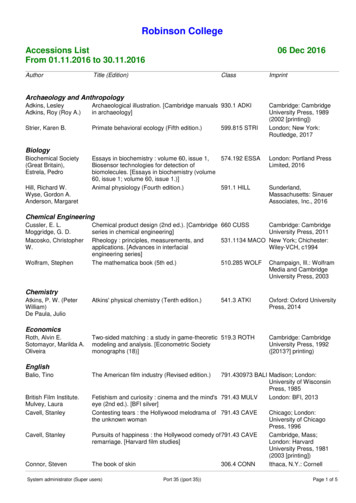BEE 473 Watershed Engineering Fall 2004
BEE 473Watershed EngineeringFall 2004RUNOFF CALCULATIONSThe following provide the minimum necessary equations for determining runoff from a designstorm, i.e., a storm with duration to the watershed’s time of concentration. When peak flow isthe critical design parameter engineers usually design for this storm duration because itrepresents the most intense storm (shortest duration) for which the entire watershed contributesflow to the outlet. This section emphasizes peak runoff; we will discuss design criteria forrunoff volume later in conjunction with ponds, flood routing, and detention basin designA. Time of Concentration:B. Rational MethodC. Curve Number Method1. Calculating Runoff Volume2. Synthetic Triangular Hydrograph3. Calculating Peak Runoff (NRCS Graphical Method)September 8, 2008
Watershed EngineeringBEE 473Fall 2004A. Time of Concentration EquationsDozens of equations have been proposed for the time of concentration. Below are four of themost commonly used that generally agree with each other within 25%. Eqs. A.3 and A.4consistently predict longer times of concentration, especially for low runoff potentials. Thefollowing were adopted from Chow (19XX)tc 0.0078L0.77S-0.385Kirpich (1940):(A.1)where tc time of concentration (min.)L length of channel or ditch from headwater to outlet (ft)S average watershed slopeSoil Conservation Service (SCS) (1972):tc L1.157700H 0.38(A.2)where tc time of concentration (hr)L length of longest flow path (ft)H difference in elevation between outlet and most distant ridgeSCS Lag Equation (1973):tc 10L0.8 [(1000/CN) – 9 ]0.7 / (1900S0.5)(A.3)where tc time of concentration (min.)L length of longest flow path (ft)S average watershed slopeCN SCS curve number[Originally developed for agricultural areas; found to be reasonable for completelyimpervious watersheds; tends to overestimate for mixed use watersheds]Federal Aviation Administration (1970):tc 1.8(1.1-C)L0.5S-0.333where tc time of concentration (min.)L length of longest flow path (ft)S average watershed slopeC rational method coefficient[Originally developed for use on airfields but frequently used for urban watersheds](A.4)
BEE 473Watershed EngineeringFall 2004B. Rational MethodThe Rational Method, a.k.a. Lloyd-Davies method if you are English, is probably the oldestrunoff equation (documented use in the 1800s) and remains very popular in urban storm waterdesign.q p CiA(ft3 s-1)(B.1)q p 0.0028CiA(m3 s-1)(B.2)where qp is the peak runoff rate, C is the runoff coefficient (tabulated based on land use), i is therainfall intensity [in hr-1 (B.1), mm hr-1 (B.2)], and A is the watershed area [acres (B.1), ha (B.2)].Remember to use a design storm with duration equal to the watershed’s time of concentration, tc.Runoff coefficients range from 0 (no runoff generated) to 1 (all rain becomes runoff). Note thatthe relationship between runoff and rainfall intensity implies Hortonian runoff processes.Tables for runoff coefficients follow.
BEE 473Watershed EngineeringFall 2004C. Curve Number Method1. Calculating Runoff VolumeThe Curve Number Equation is actually a relationship between runoff volume and rain volumebut because this method is ubiquitously used, especially for rural areas, associated methods havebeen developed to estimate peak runoff too. The basic equation is:Q ( P I a )2P Ia S(depth)(C.1)where Q is the runoff depth (to get volume, multiply by the watershed area), P is the rainfalldepth, Ia is the initial abstraction, and S is the watershed storage. All units are depth, eitherinches or mm. The initial abstraction is conceptualized as the amount of rain that falls beforerunoff is initiated; this is usually grossly assumed to be 0.2S. Eq. (C.1) is usually written as:2(P 0.2S )Q P 0.8S(depth)(C.2)The S term is determined indirectly from tables relating qualitative land use information to arunoff index called the Curve Number (CN). The CN is related to S with:1000 10CN25400S 254CNS (inches)(C.3a)(mm)(C.3a)Note that the implicit assumption that runoff is related to land use implies Hortonian runoffprocesses.CN tables follow (SCS, 1972, NEH, sec. 4).
Watershed EngineeringBEE 473Fall 20042.Synthetic Triangular HydrographOne simple way to estimate peak runoff from runoff volume is to assume a synthetic hydrographshape and relate volume and peak geometrically. There are dozens of hydrograph approachesthat can be used but the simplest is the triangular hydrograph; given the crudeness of the types ofrunoff estimates used in engineering, more sophisticated hydrograph approaches are usuallyunnecessary. The triangular hydrograph is shown below.qqpQtptrtimeFigure C.1: Schematic of a synthetic triangular runoff hydrographFrom the figure it is obvious that the peak discharge is simply:qp 2Q(t p t r )(C.4)where Q is in units of volume and the equation is unit consistent. Commonly, tp 1.1tc and therecession time, tr 1.67tp. Eq. C.4 is then:qp 2Q2.937t c(C.5)It is obviously also possible to convert peak runoff estimates into volumes using the synthetichydrograph concept.
BEE 473Watershed EngineeringFall 20043. Calculating Peak Runoff (NRCS Graphical Method)The NRCS developed a highly empirical approach to calculating peak runoff for their TR-20 andTR-55 computer programs. It uses the following equation:q p qu AQ24(C.4)where qu is a coefficient called the unit peak discharge (read from a graph), A is the watershedarea (mi2), and Q24 is the runoff from the 24-hr design event calculated with Eq. (C.2). Noticethat in this approach the impact of the watershed’s time of concentration is incorporated into thequ factor rather than the design storm duration.A chart for qu as a function of tc, P, and Ia follows that is appropriate for most of the continguousUS; other charts are available in the TR-55 manual or various texts (see references). Be carefulwith units; I recommend keeping depths in inches and areas in mi2.
BEE 473Watershed EngineeringFall 2004References:SCS. 1972. National Engineering Handbook (NEH), Section 4, Hydrology. US Gov’t Press,USDA.Chow XXXXSCS. 1986. Urban Hydrology for Small Watersheds, Technical Release-55 (TR-55). USDA.For further information:Tollner, E.W. 2002. Natural Resources Engineering. Iowa State Press, Ames. pp. 576.Ward, A.D. and S.W. Trimble. Environmental Hydrology. Lewis Publishers. New York. pp. 475.Dunne, T. and L.B. Leopold. Water in Environmental Planning. W.H. Freemanbd and Co. NewYork. pp. 818.Chin, D.A. Water Resources Engineering. Prentice Hall. Upper Saddle River. pp. 750.
(depth) (C.1) where Q is the runoff depth (to get volume, multiply by the watershed area), P is the rainfall depth, Ia is the initial abstraction, and S is the watershed storage. All units are depth, either inches or mm. The initial abstraction
Three separate watershed assessments were performed to guide the development of a watershed management plan for the North Branch Park River: 1) a Baseline Watershed Assessment, 2) a Watershed Field Assessment, and 3) a Land Use Regulatory Review. The Baseline Watershed Assessment evaluates the existing environmental and land use conditions in
your classroom bee. If you would like to be well prepared for a school spelling bee, ask your teacher for the 450-word School Spelling Bee Study List, which includes the words listed here in addition to the words at the Two Bee and Three Bee levels of difficulty. 25. admit (verb) to accept as the truth. 26.
To the 4-H Leader: The honey bee project (Books 1 - 4) is intended to teach young people the basic biology and behavior of honey bees in addition to hands-on beekeeping management skills. The honey bee project books begin with basic honey bee and insect information (junior level) and advance to instruction on how to rear honey bee colonies and
Watershed, a watershed that flows toward the Columbia River. In this way, one watershed is artificially connected to several other watersheds at once. The watershed of surface flow, the watershed where domestic water originates, and the watershed where wastewater goes
Baseline Watershed Assessment North Branch Park River Watershed Connecticut Department of Environmental Protection July 2010 146 Hartford Road Manchester, Connecticut 06040 In Cooperation With: Farmington River Watershed Association Park River Watershed Revitalization Initiative
Baby Bumble Bee I’m bringing home a baby bumble bee Won’t my mommy be so proud of me I’m bringing home a baby bumble bee OUCH! It stung me I’m squishing up my baby bumblebee Won’t my mommy be so proud of me I’m squishing up my baby bumble bee Eww, it’s yucky I’m licking up my baby bumble bee Won’t my mommy be so proud of me
Wild honey bees (also called Africanized bees) in Arizona are a hybrid of the western honey bee (Apis mellifera), and other bee subspecies including the East African lowland honey bee (Apis mellifera scutellata), the Italian honey bee . Apis mellifera ligustica, and the Iberian honey bee . Apis mellifera iberiensis. They sometimes establish colonies
Archaeological illustration. [Cambridge manuals in archaeology] 930.1 ADKI Cambridge: Cambridge University Press, 1989 (2002 [printing]) Strier, Karen B. Primate behavioral ecology (Fifth edition.) 599.815 STRI London; New York: Routledge, 2017 Biology Biochemical Society (Great Britain), Estrela, Pedro Essays in biochemistry : volume 60, issue 1, Biosensor technologies for detection of .























